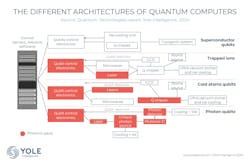Quantum continues to be a buoyant field where photonics will play a critical role
Quantum is a strategic technology domain with multifaceted implications. Quantum computing offers promising applications in healthcare, environmental conservation, and artificial intelligence (AI)—extending the boundaries of digital computing beyond current limitations. While quantum and post-quantum cryptography represent more established fields with existing economic players and commercial solutions, the standardization of post-quantum cryptography remains incomplete, albeit with fewer scientific and engineering unknowns compared to scalable quantum computing.
Beyond quantum computing, quantum cryptography has the potential to revolutionize encryption, but it poses implications for state sovereignty—particularly safeguarding sensitive communications. In sensing applications, quantum exists as a real market but is still limited to niche applications. And compared to cryptography and sensing, the maturity of quantum computing is lagging. The feasibility of commercially viable quantum computers remains uncertain, both in the near-term noisy intermediate-scale quantum (NISQ) and the long-term fault-tolerant quantum computing (FTQC) regimes.
Quantum R&D
Quantum technologies continue to be an active R&D and engineering topic for overcoming technological hurdles such as qubit noise, quantum error correction, scalability, and maintaining qubit quality. These uncertainties pose issues that still make for difficult economic and market forecasts. So the possibility of a “quantum winter” remains possible if NISQ systems fail to demonstrate tangible business value. This could potentially slow down investments across the quantum technology ecosystem—affecting public and private funding.
But, at Yole Group, we still believe quantum technologies and specialty computing will lead to an important market value in the medium and long term. In our Quantum Technologies 2024 report, we estimate the total quantum market value will be US$1.832 million in 2029, with US$617 million for sensing (see Fig. 1).1
Quantum computing
Beyond 2030, we expect quantum computing will dominate. In fact, the quantum computing market will total US$3.736 million in 2035 (both hardware and service). Quantum as a service (QaaS) will hold the major share of this value, with most of the services running on quantum computers in the cloud. It will grow much faster than QC hardware (computers).
Qubits, the fundamental units of quantum computing, come in various forms. The most developed approaches include atoms such as trapped ions (IonQ, Quantinuum, AQT), cold atoms (Pasqal, Infleqtion, Atom Computing) such as rubidium, cesium, and nuclear magnetic resonance (although the latter is less favored for quantum computing; only one company in China sells this type, and it’s for educational purposes), superconductors, and photons. Electrons are also used, particularly in nitrogen-vacancy (NV) centers, but with limited industrial players (Quantum Brilliance). Flying qubits, such as photon qubits (and flying electrons), provide alternative approaches to traditional qubits, with vendors such as PsiQuantum, Quandela, and Xanadu leading in photon qubits.
A quantum computer is based on these different types of physical qubits of a different nature, with each possessing advantages and disadvantages. Most efforts today focus on superconducting qubits, with challengers such as electron spin qubits, NV centers, cold atoms, trapped ions, and photons. No approach is ideal today, and future systems may combine several of them.
Qubits are the technological brick base for quantum computers, which come in different forms. Quantum emulators, used across a spectrum of computing devices from (non-quantum) laptops to supercomputers, execute quantum algorithms via large vector and matrix computations—providing a means to test such algorithms without quantum computers.
Quantum annealing computers use an adiabatic property, with a set of qubits connected based on specific topologies (like “Pegasus” or “Zephyr” by D-Wave), initialized in the ground state of the Hamiltonian—ensuring convergence toward a low energy state (typically the ground state) and facilitating the search for energy minima to solve various problems such as simulations, optimizations, and machine learning. Meanwhile, digital or universal quantum computers are quantum gates-based. They use qubits equipped with quantum gates capable of executing all quantum algorithms, which makes them general-purpose quantum computers.
But gate-based quantum computers currently have a limited qubit number due to quantum noise. To mitigate this noise, logical qubits made of multiple physical qubits and quantum-error correction codes (QEC) are used. Until fault-tolerant quantum computers with logical qubits become widespread, these systems will rely on non-corrected qubits in NISQ devices. These NISQ computers support 50 to a few-hundred physical qubits and can execute algorithms with limited circuit depth due to qubit error rates.
Efforts are underway to improve their performance using quantum error suppression and mitigation techniques. Eventually, NISQ devices are expected to surpass the computing capabilities of supercomputers for specific tasks. In the future, fault-tolerant quantum computers with many physical qubits and more than 100 logical qubits will revolutionize quantum computing.
Quantum accelerator
At Yole Group, we also see a quantum accelerator on the horizon, functioning as a quantum computer and complementing supercomputers or HPCs by executing variational algorithms where a classical part prepares data for the quantum accelerator and serves as an accelerator within the HPC system and requires close integration for batch loading and executing the quantum algorithm multiple times, typically containing a classical computer within itself.
Whatever the type of qubits and/or the quantum computer architecture, photonics will be of great importance to the development of quantum technologies since lasers and other photonic devices are used for trapped ion/photon/neutral atom technologies (see Fig. 2). In particular, laser systems are needed for trapped ions, cold atoms, and NV centers. Even if laser suppliers are numerous, only a few can propose systems usable for quantum applications. Indeed, agile laser systems with total frequency control, high reliability, and long lifetime are absolutely critical.
To be successful, quantum computers still need to work on size, weight, power, and cost (SWaP-C). Although quantum technologies are long-term, the time to invest is today. Developing a set of toolboxes—such as photonic systems—is a good way to have revenue in the 3- to 5-year term, while also reassuring investors.
REFERENCE
1. See www.yolegroup.com/product/report/quantum-technologies-2024.

Eric Mounier
Eric Mounier is chief analyst of Photonics & Sensing at Yole Group. He has more than 30 years’ experience within the semiconductor industry and provides daily in-depth insights into emerging semiconductor technologies such as quantum technologies, the Metaverse, terahertz, photonics, and sensing.
Based on relevant methodological expertise and a significant technological background, he works closely with all of Yole Group’s teams to highlight disruptive technologies and analyze business opportunities through technology & market reports and custom consulting projects.
He has spoken at numerous international conferences, presenting Yole Group’s vision of emerging semiconductor technologies, markets, and applications.
Previously, he held R&D and Marketing positions at CEA-Leti (France).
He has a Ph.D. in semiconductor engineering and a degree in optoelectronics from the National Polytechnic Institute of Grenoble (France).

